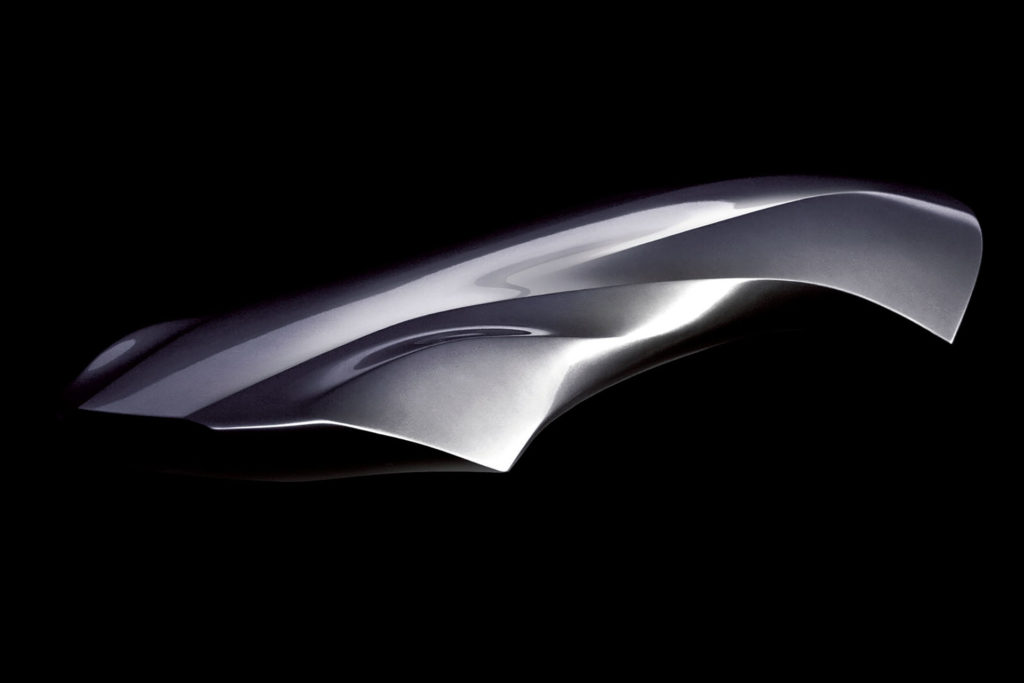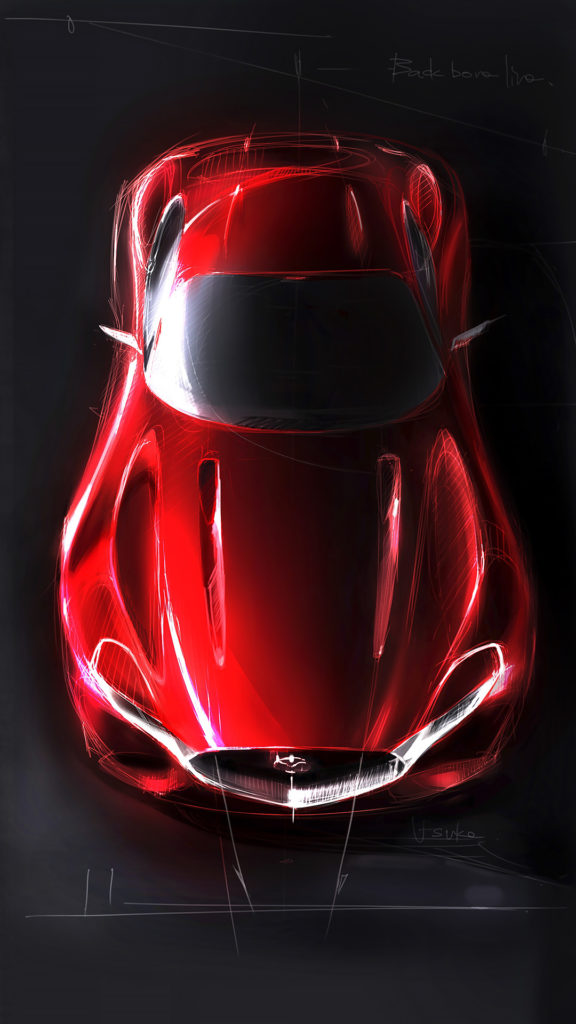
When Ikuo Maeda took the reins of Mazda’s design department in April 2009, he set himself an ambitious goal: To stay true to the brand’s identity while taking design in a bold new direction. To express Japanese aesthetics while appealing to audiences around the world. To create an object of emotional and expressive beauty with the fewest possible elements. In short: To bring out the very essence of beauty and motion and infuse it into a still object. Ten years and numerous design awards later, it is safe to say that his vision was an unbridled success.
The Birth of Kodo
As with so many things in life, Kodo Design started with a blank page and a question: How can an inanimate object capture the dynamic beauty of life itself? And, almost equally important: How can this idea be communicated clearly to everyone involved in the design process?
When Ikuo Maeda was grappling with these problems, he had just been appointed Head Designer at Mazda Motor Corporation in Hiroshima, and he had set out to redefine Mazda design.
The vision was clear: To express the “Soul of Motion”, as the design language was eventually described, in each and every Mazda car. But before even thinking about production cars, Maeda knew he needed three things: First, a name that captured the essence of what he was trying to do. Second, a physical object, a sculpture of sorts, that translated this idea in a physical form. And third, a vision model that communicated Mazda’s new design direction to customers and the world.
While coming up with a name for the new design language might seem like the most trivial of the three, it came with its own challenges.
“It’s the name that inspires designers, so choosing the right name is extremely important,” says Ikuo Maeda.
It took the team almost a year to pin down their ideas in a single word: Kodo. Literally, Kodo means “heartbeat”, but the first set of characters was changed to add another layer of meaning: the idea of imbuing something with life, of giving it a soul.
“I still remember how we were overcome with emotion when we finally got the right name,” recalls Maeda.
With this vision in mind, the design team began translating it into a physical shape. The result was a design object or sculpture that anticipates the character of the car it would inspire: the concept car Shinari, which was presented at the 2010 L.A. Motor Show.
The name evokes the powerful yet lithe appearance of steel or bamboo that is twisted or bent. In addition, the term refers to the elastic tension of a living body preparing for rapid and sudden movement.
The Shinari was often likened to a cheetah about to pounce – an image that served as the inspiration for many of the early models following Kodo Design principles.
Less is More: A Japanese Aesthetic
From the get-go, Ikuo Maeda saw the new design language as closely connected with the company’s Japanese heritage, bringing the island nation’s aesthetic ideals to a global stage.
For early models, a fusion of the natural with the artificial was especially crucial – as this is a common feature of Japanese design, art and architecture.
Just think of a bonsai tree or a traditional Japanese garden: Meticulously planned and arranged, they express the beauty of nature, carefully tamed and thereby elevated.
A similar relationship exists between the concept of the functional and the beautiful. In Japan, there is no clear-cut or ideological distinction between art and product design.
After all, the things we use every day are at least as significant to our lives as the pieces on display in a museum. We should derive the same pleasure from interacting with them, say the Japanese, that we get from an exquisite painting or sculpture.
Nowhere is this symbiosis more pronounced than in the culinary world: The setting and the pot a tea is served in is just as important as the beverage inside, and there are entire books written about the aesthetic implications of a Japanese bento box. Sure, the primary purpose of such a lunch box is to safely transport food from one place to another.
But ideally, it also heightens the overall eating experience, from the way the food is presented inside and the beauty of the box itself, to the element of delightful anticipation before discovering the treasures it holds.
The same basic principle is applied to everything from yogurt bottles to home décor, and it is the backbone of Mazda’s own “Car as Art” concept. It is this dedication to beauty even in the everyday that makes Japanese design an influential and highly successful force within the international design community.
Over the years, another staple of Japanese aesthetics has increasingly found its way into Mazda’s design philosophy: a firmly “less is more” approach.
“First and foremost, Japanese design must be simple and pure,” says Ikuo Maeda. But beyond that, “it must provide a feeling of depth within that simplicity”.
This new sensibility was even brought to iconic models like the MX-5 which, according to Maeda, comes closest to achieving ultimate beauty through purity.
Achieving this depth within a simple form requires meticulous planning and attention to detail – an approach that Mazda designers are strongly committed to.

Moving Towards the Essence
This sophisticated simplicity became the defining element of the second phase of Kodo Design, which was ushered in by two award-winning concept cars, the RX-Vision and the Vision Coupe.
Introduced at the Tokyo Motor Show 2015 and 2017, respectively, they were both crowned the “Most Beautiful Concept Car of the Year” and continue to excite fans around the world.
From this point onwards, Mazda designers sought to create beauty and a unique elegance through taking components away, not adding more. Every design element serves a purpose, nothing is superfluous or purely ornamental.
Three concepts were instrumental in this design evolution: Yohaku, the beauty of empty space, sori, or curves with poise and balance, and utsoroi, the play of light and shadow. Ikuo Maeda and his team eliminated all character lines on the car’s side panels to create a blank slate, an “empty space” that is never truly empty. Instead, the carefully turned body serves as a canvas for the light to paint on. As the vehicle moves through space, the change of light and shade creates a dynamic and fluid aspect – the “Soul of Motion” played out in the side of the car.
Despite these subtle changes over time, Ikuo Maeda is adamant that all Mazda models should express the essence of Kodo Design, without losing their individual character.
The Head Designer therefore follows what he calls a brand-led design perspective: “The job of a designer is to make sure that when our cars are placed next to each other, the line-up fascinates customers.
“It doesn’t mean that we are paying less attention to the beauty of each model, but we must create designs that enable the whole Mazda line-up to represent a unique, consistent message.”
The automotive world has received that message loud and clear – and if the accolades heaped on newer Kodo Design models are any indication, they are wanting to hear more.
In 2020 alone, both the Mazda CX-30 and the Mazda MX-30 battery-electric car received the Red Dot Award for Product Design, and the Mazda3 took home the World Car Award in the design category.
Breathing Life into a Car
In order to fulfil the promise of creating designs with a soul, the design team set up a process that combines creativity, craftsmanship and cooperation.
First comes a step called “exploratory preparation”. Every year, Mazda designers are encouraged to create their own pieces of art inspired by the principles of Kodo Design.
“There are no restrictions as to what method can be used to create an art piece,” explains Ikuo Maeda.
Mazda’s design team has created fashion and furniture, bikes as well as bowls, even a signature Kodo fragrance. Some of these unique handcrafted objects were showcased to the public during Milan Design Week in 2015.
The idea is that this free play of creative ideas will take designers off the well-trodden paths and spark exciting new ideas and unexpected shapes for upcoming models.
Next, the abstract ideas resulting from this exploratory phase need to be translated into an actual car design. Here, Mazda’s design team works closely with the master craftsmen called takumi, clay modelers that will interpret the designers’ vision into a 3D model of a car.
The design is then refined and reiterated in a process that is aptly dubbed “co-creation” – until a full-scale clay model of a car is produced and approved by all parties concerned.
While this process is certainly more time-consuming and labour-intensive than a purely virtual design, Ikuo Maeda is certain that the result is worth the extra effort.
“In Japan, we feel that craftsmen inject life into what they make, so objects that receive the love and caring attention of these craftsmen have a vital force, a soul.”
Without the involvement of the Mazda takumi, Mazda cars might still be beautiful, but they would lack the soul and the attention to detail that elevates them to the status of “Car as Art”.
The Road Ahead
Kodo Design has been pushing the limits of car design for the last decade, and it will continue to play a crucial role in the future of the Mazda brand – even as new technologies are changing some of the rules of car design.
“Electric powertrains have changed the structure of the vehicle. For example, we have motors integrated into the wheels, which leaves a lot of free space to design something new,” says Jo Stenuit, European Design Director at Mazda.
Exploring these new limits with the Kodo Design philosophy in mind will be one of the key future challenges for Mazda Design.
At the same time, the simple elegance and sophisticated beauty of the Kodo Design language will be key ingredients on the road towards a premium positioning. The direction set out here is towards ever more high-end, premium designs that include not only the car itself, but also the environment in which it is presented.
To this end, Mazda has established the Brand Style division, which ensures that the tone set by Kodo Design is reflected in everything from ad campaigns to events.
For even with ten years under its belt, Mazda’s most successful design language has lost none of its charm – and the next phase of Kodo Design is only just beginning.







